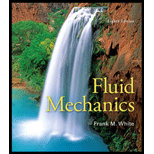
(a)
To sketch: The streamlines and location of stagnation points in the flow.
Explanation of Solution
Given information:
The strength of the flow = -m
The height of the above the floor = a
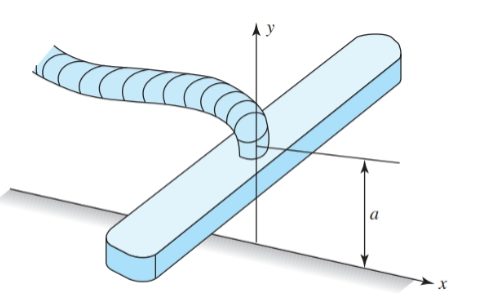
The location of the sink is (0, -a) and the location of image sink is also at (0, -a). In this, the sink and the image sink when combined make the floor for the flow. The location of the stagnation point is the origin.
This analysis is quite complex and requires modelling through a mathematical simulator to plot the streamlines of the flow. With the help of Matlab contour, the following plot has been constructed.
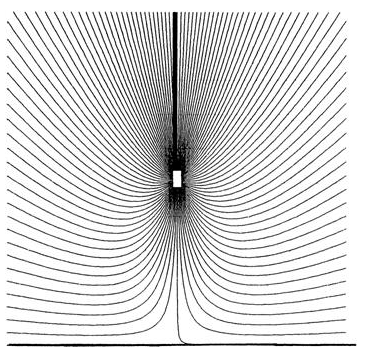
The streamlines of the flow.
Conclusion:
The streamlines are shown in the above figure and the location of stagnation point is the origin.
(b)
The magnitude of velocity V(x) along the floor in terms of parameters a and m.
Answer to Problem 8.4CP
The magnitude of velocity along the floor is
Explanation of Solution
Given information:
The strength of the flow = -m.
The height of the above the floor = a.
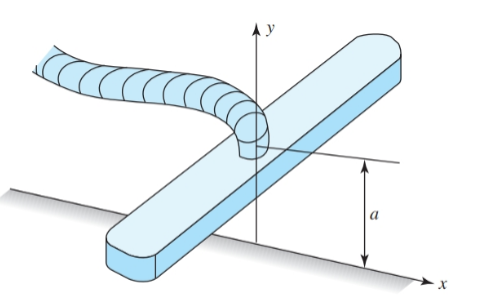
Let us consider any point x along the wall, the magnitude of velocity at this considered point will be equal to the sum of all image flow components.
Since,
At any point along the wall the velocity will be equal to
Conclusion:
Thus, the magnitude of velocity along the floor is
(c)
The variation of dimensionless pressure coefficient is
Answer to Problem 8.4CP
The variation of dimensionless pressure coefficient is
Explanation of Solution
Given information:
The strength of the flow = -m
The height of the above the floor = a
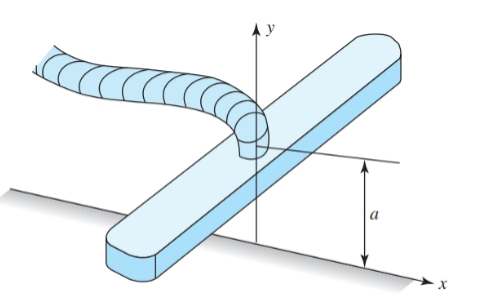
Let us use Bernoulli’s equation to calculate the pressure coefficient along the floor.
Conclusion:
Thus, variation of dimensionless pressure coefficient
(d)
The location of minimum pressure coefficient along the x-axis.
Answer to Problem 8.4CP
The location of minimum pressure coefficient along the x-axis is
Explanation of Solution
Given information:
The strength of the flow = -m
The height of the above the floor = a
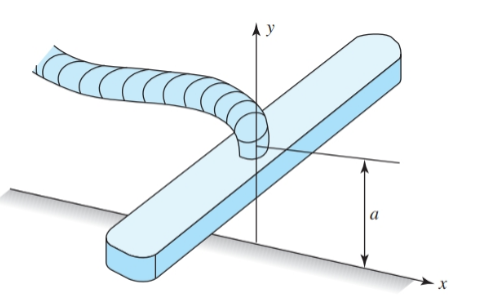
To find the location of minimum pressure coefficient along the x-axis, let us differentiate the wall pressure coefficient with respect to x and equate it to zero.
This gives,
Conclusion:
Thus, the location of minimum pressure coefficient along the x-axis is
(e)
The points along the x-axis where the vacuum cleaner works most effectively.
Answer to Problem 8.4CP
The vacuum cleaner works most effectively at
Explanation of Solution
Given information:
The strength of the flow = -m
The height of the above the floor = a
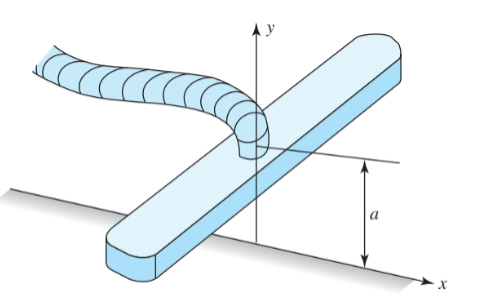
The vacuum cleaner works most effectively at the points where the pressure coefficient is minimum. Thus, the points are
Conclusion:
Thus, the vacuum cleaner works most effectively at
Want to see more full solutions like this?
Chapter 8 Solutions
Fluid Mechanics
- Auto Controls Hand sketch the root Focus of the following transfer function How many asymptotes are there ?what are the angles of the asymptotes?Does the system remain stable for all values of K NO COPIED SOLUTIONSarrow_forward-400" 150" in Datum 80" 90" -280"arrow_forwardUsing hand drawing both of themarrow_forward
- A 10-kg box is pulled along P,Na rough surface by a force P, as shown in thefigure. The pulling force linearly increaseswith time, while the particle is motionless att = 0s untilit reaches a maximum force of100 Nattimet = 4s. If the ground has staticand kinetic friction coefficients of u, = 0.6 andHU, = 0.4 respectively, determine the velocityof the A 1 0 - kg box is pulled along P , N a rough surface by a force P , as shown in the figure. The pulling force linearly increases with time, while the particle is motionless at t = 0 s untilit reaches a maximum force of 1 0 0 Nattimet = 4 s . If the ground has static and kinetic friction coefficients of u , = 0 . 6 and HU , = 0 . 4 respectively, determine the velocity of the particle att = 4 s .arrow_forwardCalculate the speed of the driven member with the following conditions: Diameter of the motor pulley: 4 in Diameter of the driven pulley: 12 in Speed of the motor pulley: 1800 rpmarrow_forward4. In the figure, shaft A made of AISI 1010 hot-rolled steel, is welded to a fixed support and is subjected to loading by equal and opposite Forces F via shaft B. Stress concentration factors K₁ (1.7) and Kts (1.6) are induced by the 3mm fillet. Notch sensitivities are q₁=0.9 and qts=1. The length of shaft A from the fixed support to the connection at shaft B is 1m. The load F cycles from 0.5 to 2kN and a static load P is 100N. For shaft A, find the factor of safety (for infinite life) using the modified Goodman fatigue failure criterion. 3 mm fillet Shaft A 20 mm 25 mm Shaft B 25 mmarrow_forward
 Elements Of ElectromagneticsMechanical EngineeringISBN:9780190698614Author:Sadiku, Matthew N. O.Publisher:Oxford University Press
Elements Of ElectromagneticsMechanical EngineeringISBN:9780190698614Author:Sadiku, Matthew N. O.Publisher:Oxford University Press Mechanics of Materials (10th Edition)Mechanical EngineeringISBN:9780134319650Author:Russell C. HibbelerPublisher:PEARSON
Mechanics of Materials (10th Edition)Mechanical EngineeringISBN:9780134319650Author:Russell C. HibbelerPublisher:PEARSON Thermodynamics: An Engineering ApproachMechanical EngineeringISBN:9781259822674Author:Yunus A. Cengel Dr., Michael A. BolesPublisher:McGraw-Hill Education
Thermodynamics: An Engineering ApproachMechanical EngineeringISBN:9781259822674Author:Yunus A. Cengel Dr., Michael A. BolesPublisher:McGraw-Hill Education Control Systems EngineeringMechanical EngineeringISBN:9781118170519Author:Norman S. NisePublisher:WILEY
Control Systems EngineeringMechanical EngineeringISBN:9781118170519Author:Norman S. NisePublisher:WILEY Mechanics of Materials (MindTap Course List)Mechanical EngineeringISBN:9781337093347Author:Barry J. Goodno, James M. GerePublisher:Cengage Learning
Mechanics of Materials (MindTap Course List)Mechanical EngineeringISBN:9781337093347Author:Barry J. Goodno, James M. GerePublisher:Cengage Learning Engineering Mechanics: StaticsMechanical EngineeringISBN:9781118807330Author:James L. Meriam, L. G. Kraige, J. N. BoltonPublisher:WILEY
Engineering Mechanics: StaticsMechanical EngineeringISBN:9781118807330Author:James L. Meriam, L. G. Kraige, J. N. BoltonPublisher:WILEY





